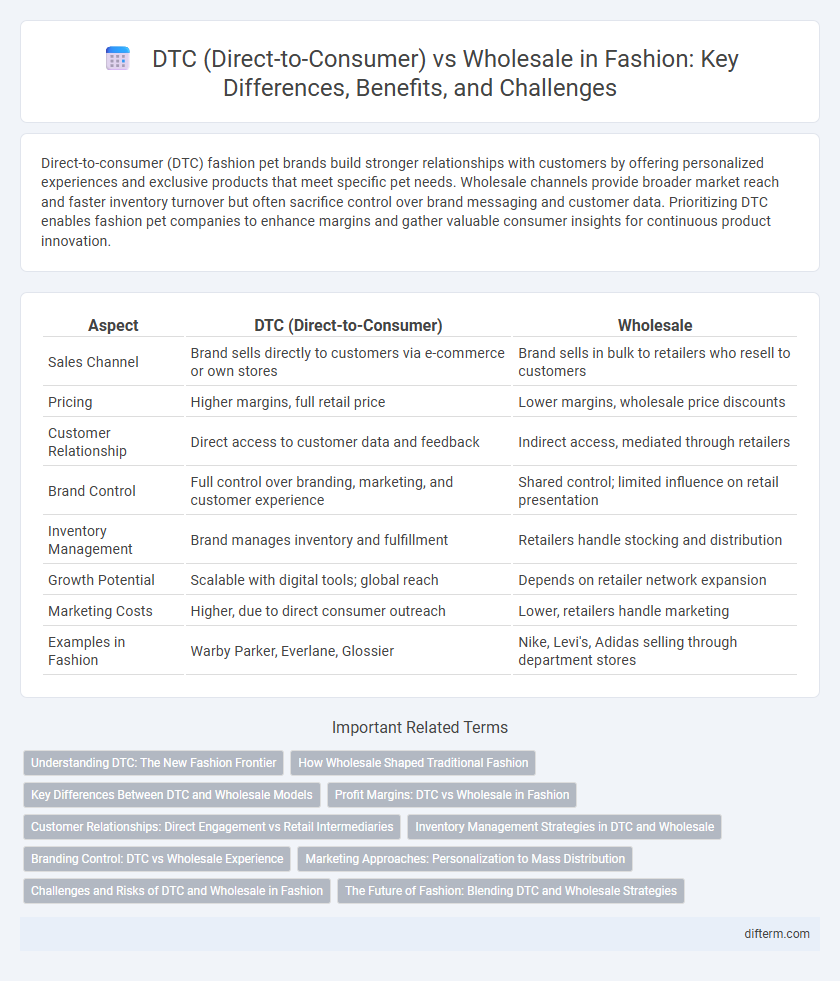Direct-to-consumer (DTC) fashion pet brands build stronger relationships with customers by offering personalized experiences and exclusive products that meet specific pet needs. Wholesale channels provide broader market reach and faster inventory turnover but often sacrifice control over brand messaging and customer data. Prioritizing DTC enables fashion pet companies to enhance margins and gather valuable consumer insights for continuous product innovation.
Table of Comparison
| Aspect | DTC (Direct-to-Consumer) | Wholesale |
|---|---|---|
| Sales Channel | Brand sells directly to customers via e-commerce or own stores | Brand sells in bulk to retailers who resell to customers |
| Pricing | Higher margins, full retail price | Lower margins, wholesale price discounts |
| Customer Relationship | Direct access to customer data and feedback | Indirect access, mediated through retailers |
| Brand Control | Full control over branding, marketing, and customer experience | Shared control; limited influence on retail presentation |
| Inventory Management | Brand manages inventory and fulfillment | Retailers handle stocking and distribution |
| Growth Potential | Scalable with digital tools; global reach | Depends on retailer network expansion |
| Marketing Costs | Higher, due to direct consumer outreach | Lower, retailers handle marketing |
| Examples in Fashion | Warby Parker, Everlane, Glossier | Nike, Levi's, Adidas selling through department stores |
Understanding DTC: The New Fashion Frontier
DTC (direct-to-consumer) revolutionizes fashion by enabling brands to control the entire customer experience from production to sale, bypassing traditional wholesale channels. This model leverages digital platforms and personalized marketing to build stronger consumer relationships and higher margins. Leading fashion brands utilize DTC strategies to gather real-time data, enhancing product development and driving faster market responsiveness.
How Wholesale Shaped Traditional Fashion
Wholesale has historically shaped traditional fashion by enabling large-scale distribution through established retail networks, allowing brands to reach diverse markets efficiently. This model supports bulk production and economies of scale, which lower costs and stabilize supply chains for designers and manufacturers. Wholesale's emphasis on retailer partnerships has influenced fashion cycles and inventory management, reinforcing seasonal collections and trend adoption.
Key Differences Between DTC and Wholesale Models
DTC fashion brands maintain direct control over customer experience, pricing, and branding while collecting valuable consumer data for personalized marketing. Wholesale models rely on third-party retailers to distribute products, limiting control over pricing and customer interactions but enabling rapid market expansion through established retail networks. Inventory management in DTC involves handling fulfillment directly, whereas wholesale often requires bulk production and shipment to various retail partners.
Profit Margins: DTC vs Wholesale in Fashion
Direct-to-consumer (DTC) fashion brands typically achieve profit margins up to 60-70% by eliminating intermediaries and controlling pricing strategies, compared to wholesale margins around 30-40% where retailers take significant cuts. DTC models leverage data-driven marketing and personalized customer experiences, enhancing repeat purchases and lifetime value, while wholesale depends heavily on volume and retailer discounts. Higher profit margins in DTC also allow greater investment in product innovation and brand building within competitive fashion markets.
Customer Relationships: Direct Engagement vs Retail Intermediaries
DTC (direct-to-consumer) brands foster stronger customer relationships through personalized interactions, real-time feedback, and tailored marketing strategies, enabling deeper brand loyalty and enhanced customer lifetime value. In contrast, wholesale models rely on retail intermediaries that limit direct engagement, reducing opportunities for brands to gather detailed consumer insights or control the customer experience. This direct engagement in DTC channels drives higher customer satisfaction and empowers brands to quickly adapt to evolving consumer preferences.
Inventory Management Strategies in DTC and Wholesale
DTC fashion brands utilize real-time inventory management systems to maintain lean stock levels, reducing carrying costs and quickly adapting to consumer trends. Wholesale channels require bulk inventory forecasts with safety stock buffers to meet retailer demands and prevent stockouts during seasonal peaks. Integrating demand forecasting and inventory tracking software is critical for optimizing supply chain efficiency in both DTC and wholesale models.
Branding Control: DTC vs Wholesale Experience
Direct-to-consumer (DTC) brands maintain full branding control, allowing for consistent messaging, personalized customer experiences, and stronger brand identity management. Wholesale channels often dilute brand narratives due to third-party retail influence, limiting the ability to tailor marketing and customer engagement. Effective branding control through DTC fosters deeper customer loyalty and more direct feedback for continuous brand refinement.
Marketing Approaches: Personalization to Mass Distribution
DTC fashion brands leverage personalization by utilizing customer data and AI-driven marketing to tailor product recommendations and experiences, enhancing customer loyalty and lifetime value. Wholesale models prioritize mass distribution, focusing on broad reach through retail partnerships and standardized marketing campaigns that emphasize brand visibility over individualized customer engagement. The shift towards DTC enables brands to control brand narrative and collect first-party data, driving targeted marketing strategies that outperform traditional wholesale approaches.
Challenges and Risks of DTC and Wholesale in Fashion
Direct-to-consumer (DTC) fashion brands face challenges such as high customer acquisition costs, complex logistics, and managing inventory without wholesale partnerships. Wholesale presents risks including lower profit margins, dependency on retailers, and reduced control over brand presentation and pricing. Both models require careful balance to optimize supply chain efficiency and maintain sustainable growth in a competitive market.
The Future of Fashion: Blending DTC and Wholesale Strategies
The future of fashion hinges on integrating DTC and wholesale strategies to maximize reach and profitability. Brands leveraging DTC gain valuable consumer insights and control over brand experience, while wholesale channels provide expanded market access and enhanced distribution efficiency. Combining these models enables fashion companies to optimize inventory management and adapt quickly to evolving consumer trends.
DTC (direct-to-consumer) vs wholesale Infographic

 difterm.com
difterm.com